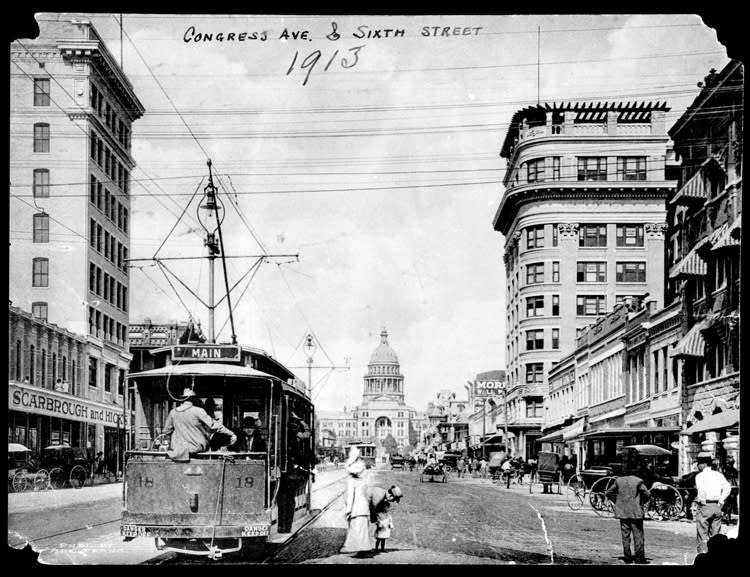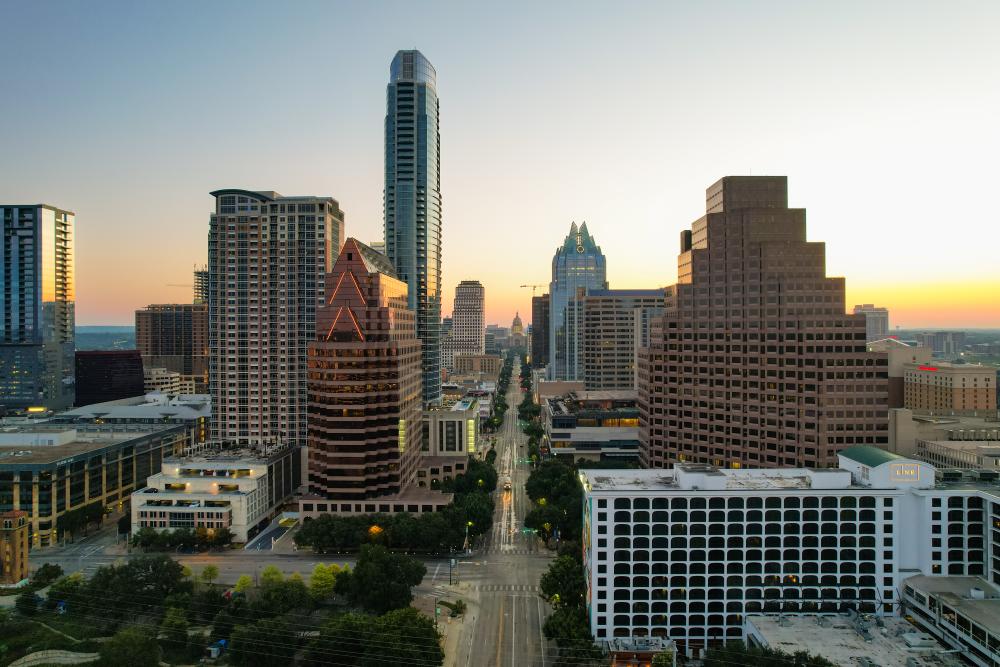Congress Avenue isn’t just Austin’s main street – it is the main street of Texas. Mirabeau Lamar, successor to Sam Houston as president of the newborn Republic of Texas, directed that a city be built here in 1839, specifically for the seat of government. His plan called for a 120-foot wide ceremonial boulevard from the river to the hilltop Capitol. Ever since then, the street has been the site of parades, demonstrations, athletic events, movie shoots and street parties.

Congress Avenue & Sixth Street. C02001, Austin History Center, Austin Public Library.
Congress Avenue History
There are no buildings remaining on the avenue from Lamar’s time in office – the oldest dates from around 1856. Most of the historic buildings were built after 1871, the year the railroad arrived, bringing prosperity to the city. Victorian and Classical styles were popular, with adaptations for local weather and available materials. Limestone was often used, as it was plentiful and adaptable to many building techniques. Porticoes provided shelter from the elements and perches for viewing the happenings on the street. The 20th century brought Beaux Arts, Chicago and Deco styles to the Avenue.
During the 1940s and 1950s, old styles fell from favor; many of the buildings were demolished or covered with modern façades. Suburbanization followed, causing the loss of most of the avenue’s retail businesses. Large office towers rose up. The 1970s saw a resurgence of appreciation for the historic buildings that remained. Restoration projects took place up and down the street. Today Congress Avenue is a National Register Historic District that continues to evolve with time.
 Congress Avenue. Credit David Aguilar.
Congress Avenue. Credit David Aguilar.
Historic Buildings on Congress Avenue
The Old Bakery & Emporium
1006 Congress Ave.
Swedish immigrant Charles Lundberg and his successors operated a bakery for many years in this 1876 building. Visitors can explore the Lundberg-Maerki Historical Collection and Art Gallery, get information about the city and shop for art and crafts by local artisans.
Walter Tips Building
710 Congress Ave.
This impressive building with its Venetian façade was designed in 1876 by J. N. Preston for the headquarters of The Walter Tips Company for machinery and ironworks. An example of the company’s product can be seen in the lobby. The building’s support girder is made of scrap iron from exploded Confederate shells.
Paramount Theatre
713 Congress Ave.
The Paramount began in 1915 as the Majestic, a vaudeville theatre designed by John Eberson of Chicago, with G. A. Endress. Under the stewardship of the nonprofit Austin Theatre Alliance, both the Paramount and adjacent 1935 State Theatre host live performances, festivals and films.
Stephen F. Austin Royal Sonesta Hotel
701 Congress Ave.
The Stephen F. Austin hotel, named after the “father of Texas,” was originally built in 1924 as Austin’s first high-rise hotel on Congress Avenue. The historic hotel was the first building in Austin to feature a lighted roofline and the Longhorn Garden was equipped with 125 multi-paned windows, featuring incredible views of Downtown and the Capitol. The terrace was removed in 1938 after the hotel added five new floors.
Scarbrough Building
101 W. Sixth St.
This corner was the site of the first store ever built in Austin. Many years later, in 1910, it became the site of Austin’s preeminent department store, Scarbrough’s. Architects Sanguinet and Staats designed the eight-story, Chicago-style building. Deco alterations were made in 1929. Competition from suburban malls forced the store’s closure in 1983, but in recent years retail activity has returned to the building and the avenue. Now, you can dine on steaks at Ruth's Chris or tacos at Velvet Taco. Or play games at Punch Bowl Social, with design nods to some of the building's original stores like a men's suit shop.
Littlefield Building
106 E. Sixth St.
Cattle baron George W. Littlefield wasn’t satisfied with his new Beaux Arts-style bank building in 1912. He converted its roof garden to create a ninth story, making it the tallest building in Austin for a time. C. H. Page, Jr. was the architect.
For more history, view one of Preservation Austin's self-guided tours of Austin’s historic places. Or learn more about Historic Austin with a guided Downtown Walking Tour!

